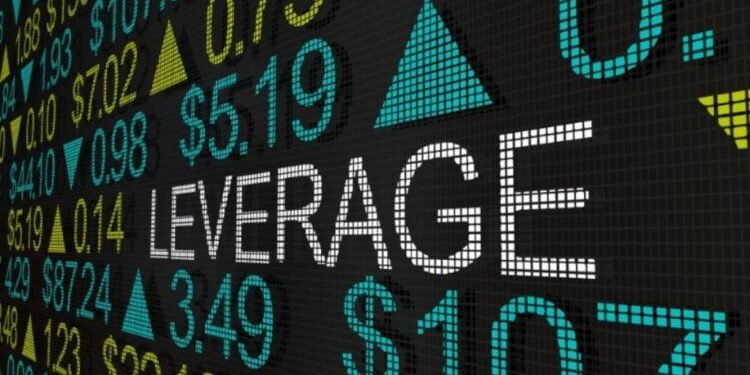What Is Leverage: A Very Easy Guide
Even experienced traders may forget what leverage is in trading. It’s crucial to understand the concept of leverage in both Forex and crypto markets. So, if you want to figure it out, we’re here to help. This article addresses both areas, providing a comprehensive overview so you don’t need to read multiple sources to learn about Forex and crypto.
In trading, leverage refers to the use of borrowed funds (typically provided by the broker) to increase the potential return on investment. It allows traders to control a larger position with a smaller amount of capital. Leverage in forex trading also means you can increase your profits when the market moves in your favour.
However, it also means you risk losing all your capital if the market moves against you.
Forex leverage allows traders to borrow capital to gain greater exposure to the forex market. With limited capital, traders can control larger transaction sizes, potentially increasing profits and losses. This is because profits and losses are based on the full value of the positions.
No worries, it’s simple! Just remember that those profit and loss Placements are based on the total value of the transaction, not just your deposit.
Interestingly, Forex trading margin rates are some of the lowest in the financial market.
What Is Leverage Ratio in Trading?
In trading, the leverage ratio, also known simply as leverage, refers to the proportion of debt (or borrowed funds) relative to equity or the total capital invested. It is expressed as a ratio and indicates how much capital a trader can control in relation to their own funds.
Often, the more volatile or less liquid the target market, the less leverage you have to protect your position against rapid price changes. On the other hand, highly liquid markets, such as the cryptocurrency market, can have particularly high leverage ratios.
Risks of Leverage in Forex Trading
Understanding the risks associated with leverage in Forex trading is crucial for any trader. While leverage can amplify potential returns, it also magnifies risks significantly.
Effective risk management is paramount when using leverage. Brokers offering high leverage typically provide risk management tools to mitigate potential downsides. These tools are essential for traders to navigate the complexities of leveraged trading safely.
Stop-Loss Orders
A stop-loss order specifies a price level below the current market price (for a long position) or above the current market price (for a short position) at which the trader wants to exit the trade automatically. Thanks to stop-loss orders, you can minimize your losses in adverse markets by excluding you from a trade that moves against you at the price the trader sets.
Is it a good idea to use stop-loss orders?
Essentially, you establish the level of risk you are comfortable with for a trade. The validity of the stop-loss doesn’t guarantee the closing price due to possible slippage. To create a well-rounded trading strategy, successful traders often combine stop loss orders with other risk management techniques, such as position sizing, diversification, and proper analysis of entry and exit points.
There are several types of stop-loss orders:
Fixed Stop Loss: This is a straightforward stop loss order where the price level is set manually by the trader.
Trailing Stop Loss: This type of stop loss order moves automatically with the price in favour of the trade. A trailing stop-loss operates the same as a conventional stop-loss. On the other hand, if the market goes in your favour, the trailing stop-loss will adjust accordingly in an attempt to mitigate any potential losses and capture positive price movements.
Guaranteed Stop Loss: A guaranteed stop-loss order (GSLO) ensures that your trade will be executed at your desired price, regardless of market fluctuations or gaps in the market.
Overall, stop-loss orders are crucial tools for traders to protect their investments and manage risk effectively in the dynamic and sometimes volatile world of financial markets.
Take-Profit Order
In leverage trading, take-profit orders play a crucial role in managing trades by helping traders capitalize on price movements.
A take-profit order (often abbreviated as TP) is an instruction given to a broker to close a position at a predetermined price that is favorable to the trader. It is placed above the current market price for a long position or below the market price for a short position.
The primary purpose of a take-profit order is to lock in profits when a trade moves in the trader’s favor. It allows traders to specify a target level at which they want to secure their gains automatically without needing to monitor the market constantly.
How to Minimize the Risk?
Setting a trade risk limit is crucial when sizing currency positions. Minimizing risk in leverage trading is essential to protect your capital and optimize your trading strategy. Set a percentage or dollar risk limit for each trade. If you have a $10,000 trading account, you risk $100 on each trade using a 1% limit.
Here are some tips fr beginners in leverage trading:
Start with low leverage ratios.
Educate yourself thoroughly on how leverage works.
Practice with demo accounts before trading with real money.
Begin with small position sizes relative to your account balance.
Always use stop-loss orders to limit potential losses.
Set clear risk limits for each trade.
Avoid overtrading and stick to your trading plan.
Learn from both successful trades and mistakes.
Seek guidance from reputable educational resources.
Stay patient, disciplined, and focused on long-term improvement.
What Is Leverage in Crypto Trading?
Let’s delve into an important question: what is leverage in crypto trading?
First, let’s explore how leverage is utilized in the crypto market. In crypto trading, leverage allows you to borrow money from a platform to make bigger trades than what you can afford with your own funds. For example, with 10:1 leverage, you can trade $10,000 worth of cryptocurrency with only $1,000 of your own money.
Margin Trading
Brokers or exchanges offering leverage require traders to maintain a minimum amount of capital (margin) in their accounts to cover potential losses. If losses reduce the account balance below this level, a margin call may occur, requiring additional funds or closing of positions. Margin trading is when a trader borrows money from a crypto exchange to make bigger trades. They use their money as a guarantee and can make trades worth more than what they have.
When you trade on an exchange, they have rules about how much money you need to have in your account at all times. If you don’t have enough money, they may sell your investments to cover the costs. You only make or lose money when you sell your investments.
Crypto Options
Options contracts give the buyer the right, but not the obligation, to buy or sell the underlying crypto asset at a specified strike price on or before expiration. The seller/writer assumes the obligation to exercise the option if the buyer exercises the option.
Risks of Leverage in Crypto Trading
As mentioned earlier, leverage allows traders to increase potential profits, but it also increases potential losses. But is it safe? The risks of leverage in crypto trading are substantial and should be carefully considered by traders:
Volatility: Crypto markets are extremely volatile, and frequent double-digit price swings aren’t uncommon, making crypto markets particularly risky for leveraged trading when the price moves unfavourably.
Liquidation: In the case of leveraged trading, borrowed funds are used as collateral. If the market develops unfavourably, failure to meet the margin requirements may mean the exchange liquidating the position to cover the loss.
Interest charges: Margin trading often involves paying interest on borrowed funds. This can affect the overall profitability of leveraged positions.
Counterparty risk: Taking leveraged positions through exchanges or lending platforms exposes traders to counterparty risk. Reliance on the abovementioned platforms to leverage funds may expose traders to potential platform failures, etc.
Understanding what leverage is in trading is crucial when navigating Forex and Crypto markets. It can boost your trading potential, but it’s important to be careful and not rush decisions. Overall, leverage can be a powerful tool for traders looking to amplify their potential gains, but it requires careful consideration of risk management strategies to avoid large losses.
Do thorough research and use strong risk management strategies to minimize risks. When used wisely, leverage can be a dependable tool, enhancing your trading skills in the exciting world of Forex and Crypto.
The post What Is Leverage In Trading? appeared first on FinanceBrokerage.
















